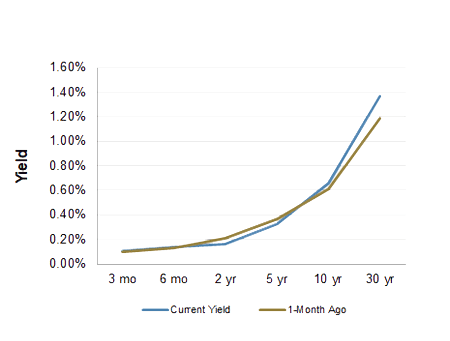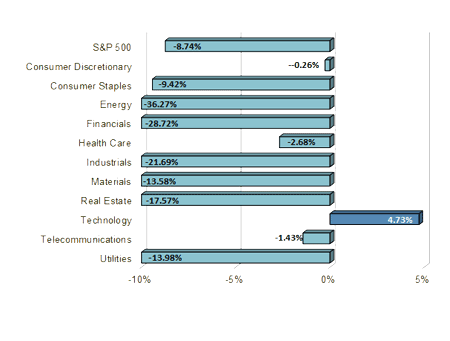Chief Economist Scott Brown discusses the latest market data.
The stock market was choppy as investors bounced between hopes for a successful reopening of the economy and fears of a more prolonged slowdown. In his testimony to the Senate Banking Committee, Fed Chair Powell stuck to monetary policy (the economic impact of the pandemic and the central bank’s efforts to counter that). Surprisingly, he refrained from prodding Congress to provide more fiscal support (as he had done in a speech a week earlier). FOMC minutes from the April 28-29 policy meeting showed no discussion of negative interest rates, but officials are considering a program to purchase Treasury on an ongoing basis aimed at keeping long-term interest rates low.
No surprise, April building permits (-20.8%) and housing starts (-30.2%) fell sharply. Homebuilder sentiment improved but remained weak. Jobless claims fell to 2.438 million in the week ending May 16 – trending lower but extremely elevated. Continuing claims, totaling more than 25 million for the week ending May 9, are still trending higher.
Next week, jobless claims will remain the key indicator to watch. The second estimate of 1Q20 GDP growth is expected to be little changed from the advance estimate, but investors are more concerned with the expected sharp decline in 2Q20 and the prospects for a second half rebound. Personal income and spending figures for April will help to gauge the second quarter damage. Durable goods orders are quirky even in the best of times, but March was bizarre – aircraft order cancellations (which count as negative orders) pushed the headline figure lower, while other sectors held up surprisingly well. Fewer aircraft order cancellations may add to overall orders in April, while other sectors should weaken. Fed Chair Powell will discuss the economy on Friday.
Indices
| Last | Last Week | YTD return % | |
|---|---|---|---|
| DJIA | 24474.12 | 23625.34 | -14.24% |
| NASDAQ | 9284.88 | 8943.72 | 3.48% |
| S&P 500 | 2948.51 | 2852.50 | -8.74% |
| MSCI EAFE | 1656.36 | 1588.17 | -18.68% |
| Russell 2000 | 1347.56 | 1237.55 | -19.23% |
Consumer Money Rates
| Last | 1 year ago | |
|---|---|---|
| Prime Rate | 3.25 | 5.50 |
| Fed Funds | 0.00 | 2.37 |
| 30-year mortgage | 3.03 | 4.10 |
Currencies
| Last | 1 year ago | |
|---|---|---|
| Dollars per British Pound | 1.222 | 1.267 |
| Dollars per Euro | 1.095 | 1.115 |
| Japanese Yen per Dollar | 107.61 | 110.36 |
| Canadian Dollars per Dollar | 1.396 | 1.344 |
| Mexican Peso per Dollar | 22.865 | 18.987 |
Commodities
| Last | 1 year ago | |
|---|---|---|
| Crude Oil | 33.92 | 61.42 |
| Gold | 1721.90 | 1279.50 |
Bond Rates
| Last | 1 month ago | |
|---|---|---|
| 2-year treasury | 0.16 | 0.21 |
| 10-year treasury | 0.66 | 0.61 |
| 10-year municipal (TEY) | 1.37 | 1.94 |
Treasury Yield Curve – 05/22/2020

As of close of business 05/21/2020
S&P Sector Performance (YTD) – 05/22/2020

As of close of business 05/21/2020
Economic Calendar
| May 25 | — | Memorial Day Holiday (markets closed) |
| May 26 | — | New Home Sales (April) |
| — | CB Consumer Confidence (May) | |
| May 27 | — | Fed Beige Book |
| May 28 | — | Jobless Claims (week ending May 23) |
| — | Real GDP (1Q20, 2nd estimate) | |
| — | Durable Goods Orders (April) | |
| — | Leading Economic Indicators (April) | |
| May 29 | — | Personal Income and Spending (April) |
| — | Chicago Business Barometer (May) | |
| — | UM Consumer Sentiment (May) | |
| — | Powell Discussion (Princeton, via webcast) | |
| June 1 | — | ISM Manufacturing Index (May) |
| June 3 | — | ADP Payroll Estimate (May) |
| — | ISM Non-Manufacturing Index (May) | |
| June 5 | — | Employment Report (May) |
| June 10 | — | FOMC Policy Decision |
| July 29 | — | FOMC Policy Decision |
All expressions of opinion reflect the judgment of the Research Department of Raymond James & Associates, Inc. and are subject to change. There is no assurance any of the forecasts mentioned will occur or that any trends mentioned will continue in the future. Investing involves risks including the possible loss of capital. Past performance is not a guarantee of future results. International investing is subject to additional risks such as currency fluctuations, different financial accounting standards by country, and possible political and economic risks, which may be greater in emerging markets. While interest on municipal bonds is generally exempt from federal income tax, it may be subject to the federal alternative minimum tax, and state or local taxes. In addition, certain municipal bonds (such as Build America Bonds) are issued without a federal tax exemption, which subjects the related interest income to federal income tax. Municipal bonds may be subject to capital gains taxes if sold or redeemed at a profit. Taxable Equivalent Yield (TEY) assumes a 35% tax rate.
The Dow Jones Industrial Average is an unmanaged index of 30 widely held stocks. The NASDAQ Composite Index is an unmanaged index of all common stocks listed on the NASDAQ National Stock Market. The S&P 500 is an unmanaged index of 500 widely held stocks. The MSCI EAFE (Europe, Australia, Far East) index is an unmanaged index that is generally considered representative of the international stock market. The Russell 2000 index is an unmanaged index of small cap securities which generally involve greater risks. An investment cannot be made directly in these indexes. The performance noted does not include fees or charges, which would reduce an investor’s returns. U.S. government bonds and treasury bills are guaranteed by the US government and, if held to maturity, offer a fixed rate of return and guaranteed principal value. U.S. government bonds are issued and guaranteed as to the timely payment of principal and interest by the federal government. Treasury bills are certificates reflecting short-term (less than one year) obligations of the U.S. government.
Commodities trading is generally considered speculative because of the significant potential for investment loss. Markets for commodities are likely to be volatile and there may be sharp price fluctuations even during periods when prices overall are rising. Specific sector investing can be subject to different and greater risks than more diversified investments. Gross Domestic Product (GDP) is the annual total market value of all final goods and services produced domestically by the U.S. The federal funds rate (“Fed Funds”) is the interest rate at which banks and credit unions lend reserve balances to other depository institutions overnight. The prime rate is the underlying index for most credit cards, home equity loans and lines of credit, auto loans, and personal loans. Material prepared by Raymond James for use by financial advisors. Data source: Bloomberg, as of close of business May 21, 2020.
Markets & Investing Members of the Raymond James Investment Strategy Committee share their views on...
Markets & Investing Review the latest Weekly Headings by CIO Larry Adam. Key Takeaways ...
Technology & Innovation Learn about a few simple things you can do to protect your personal information...